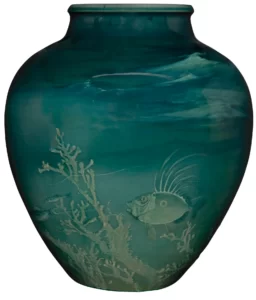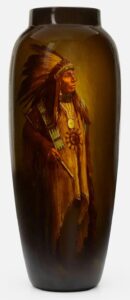A Deep Dive for Buyers, Sellers and Collectors of Rookwood Pottery
This website is a catalogue raisonné and repository of sales data of Rookwood Pottery. Entries are indexed by shape number (see Markings), and can also be searched by date, artist name, description, or can simply be browsed page by page (40 entries per page). The site is provided as a free public service to collectors. Users are invited to contribute by submitting information about their own Rookwood pieces.
To submit a listing, click on “Submit an Item” above and provide the requested information and photos. The administrator will review your submission and when approved it will become part of the database. Entries shall remain anonymous.
Users’ email addresses are requested for submissions and questions in order for us to respond, they are not shared for advertising, tracking, or any other purpose, with one exception: if you want to sell an item, simply state “For Sale” in the Comments field, and Admin will be happy to pass along the email address of anyone who expresses interest. The rest of course is up to you.
The goal of this database is to list examples of all the approximately 4,100 Rookwood shapes; however completeness depends on the voluntary participation of collectors and can be achieved only over time. (Website created June 2021.)
Prices shown herein reflect sale price or hammer price plus premium. Prices are as reported and unverified. Where different buyer’s premium percentages are available on different bidding platforms, the lowest percentage is used. Where a price is described as “allocated,” the piece was one of multiple pieces in a single lot and the price of the lot was allocated using Admin’s best judgment.
Stated dimensions are approximate and unverified.

The most expensive piece on this website is the Sea Green glaze vase at right, decorated by William P. McDonald, which passed for $36,250 at Treadway in December 2023. (Shape number 1182(S), 14” high x 13″ diameter.) The least expensive piece is the Z-line mug shape #345Z, which was snagged at Goodwill for $1.
Current Market Conditions
Rookwood saw its heyday in the 1990s and early 2000s, with desirable pieces passing at major auctions for $200-$1,000 per inch. However the market nosedived during the period roughly from 2008-2020. Since 2020 the market has remained lethargic with respect to production pieces, while showing some resilience as to artist-signed items, particularly landscape vases.
As of 2024, post-1920 production pieces measuring 5″ to 7″ in height are commonly available in the range of $100-$200, with run-of-the-mill items often going under $100.
 Demand for Standard glaze florals is weak; such items often pass for less than $50 per inch. On the other hand, Standard glaze Indian portrait vases, with their strong historical resonance, commonly command north of $200 per inch. The Indian portrait floor vase shown at left, decorated by Matthew A. Daly, sold for $12,600 at Toomey & Co. in December 2023. (Shape 1577(S2), 20″ h x 7-3/4″ dia; see also, e.g., shape 614(83), 707(6), 886(4).)
Demand for Standard glaze florals is weak; such items often pass for less than $50 per inch. On the other hand, Standard glaze Indian portrait vases, with their strong historical resonance, commonly command north of $200 per inch. The Indian portrait floor vase shown at left, decorated by Matthew A. Daly, sold for $12,600 at Toomey & Co. in December 2023. (Shape 1577(S2), 20″ h x 7-3/4″ dia; see also, e.g., shape 614(83), 707(6), 886(4).)
Z-line pieces (see History) command healthy prices, often in the neighborhood of $75 per inch.
Artist-signed landscape vases go for around $100 per inch and up (banded somewhat less), while demand is weaker for more-plentiful artist-signed florals, with lesser artists averaging $50-$75 per inch. Certain specialized items bring disproportionately high prices, such as modernistic vases by Jens Jensen depicting fanciful stylized animals or French Red incised vases by Sara Sax. These pieces pass well into four figures.
Pieces signed by the most highly esteemed Rookwood artists, especially Shirayamadani, are prone to overvaluation. Collectors seem to develop “auction fever” for these artists, even when the particular piece is substandard or banal. Don’t let a famous name derail your critical sensibilities.
An X marking generally reduces market value by at least 20%, even when there is no visible flaw. (See Markings.) This can create buying opportunities for knowledgeable buyers.
These are only loose guidelines, as prices are subject to wide fluctuations according to the characteristics of individual pieces and who happens to be bidding. And reputable auction houses often command significantly higher prices. A cool head and an informed perspective are indispensable.
Advice for Collectors
In the horse-and-buggy days (i.e., the 20th century), art pottery sales were the province of antique dealers. Their personal connections with collectors, estate sellers and fellow dealers enabled them to buy low and sell high, even to support a bricks-and-mortar retail store. No longer. Online sales and relatively affordable shipping have revolutionized the market. Now any seller can reach a wide audience and collectors can peruse on a daily basis literally thousands of objects newly put up for sale or auction. Moreover, thanks to saved searches on websites like eBay and LiveAuctioneers, links to new listings of Rookwood or other items of interest pop into our inboxes every day.
In the electronic marketplace, dealers looking for inventory now find themselves competing directly with collectors. As a result, collectors have become reluctant to pay dealer markups, which can double the price you might pay at auction. The upshot of this “democratization” is that auction markets are booming, while the arbitrage practiced by traditional dealers is fading. Dealers are being relegated to catering to blank-check interior decorators and the Gettys, Streisands and Spielbergs of this world. Meanwhile collectors sift daily through hundreds of online listings, searching for a needle in a haystack.
So how much is that coveted piece worth? Auction prices are a mystery wrapped in a riddle, inside an enigma — and they are subject to manipulation by unscrupulous auctioneers, a practice difficult to prove and punish.
Some items go for more than the market would predict, and others seem to slip through “under the radar” at bargain prices. The better-known auction houses often command higher prices. Since they sell the rare items collectors lust after, the heavy hitters come out of the cyber-woodwork.
On the other hand, when an obscure auction house offers an isolated gem—say a Vellum glaze piece signed by Hurley or Rothenbusch—fewer bidders seem to show up.
When it comes to Rookwood, the leading auction house is Toomey & Co., not only in terms of number and quality of pieces sold but in expertise, reflected in the item descriptions.
Auctions are not for the faint of heart, ill-informed or reckless. When bidding, carefully examine the listing in advance, ask questions about condition and dimensions, request more photos if necessary, and compare recent sale prices for similar items. That’s where this website comes in handy! You might even find that the very piece you are considering was recently sold at auction and the buyer reneged or it is being turned around for a quick profit (or loss!).
Decide the maximum you will pay, bearing in mind the buyer’s premium (the commission charged by auction houses that is added to the hammer price) and shipping cost (get quotes in advance). Stick to your guns and don’t get carried away in the bidding. You will sometimes be outbid but when that happens, move on with the knowledge that new and desirable items are coming on the market every day.
Buying on eBay presents several advantages over auction houses: 1) there is no buyer’s premium; 2) generally lower shipping costs (provided in advance so there’s no need to ask for quotes); 3) eBay’s pro-buyer policies guarantee a full refund if an item is not as described, e.g., damaged in transit or size discrepancy; and 4) freedom from the higher prices that big-name auction houses sometimes command. On the other hand, eBay’s disadvantages are 1) steep seller fees (around 15%), which sellers must factor into prices; and 2) sellers’ often-unrealistic expectations about pricing (see Pricing, below).
Buy for the privilege of being custodian of the piece, not for investment. Avoid sellers who profiteer, disguise shortcomings or use superlatives in descriptions. They are vexatious! Do your homework, read and re-read books on the subject, watch the market. Facebook groups such as Rookwood Pottery and Pottery Collector can be useful sources of information and camaraderie, but beware of self-styled “experts” who are not as knowledgeable as they think they are.
“Luck,” says cultural pundit Fran Lebowitz, “is the most important thing in life.” Be that as it may, luck undeniably plays a role in collecting. We’ve all heard the stories about finding a rare and valuable piece in a thrift store. But in order to get lucky you need knowledge of the subject and the time and patience to do a lot of searching. The more sources and contacts you can cultivate the better, even if the only apparent payoff is friendly conversation. It is unknowable when, or if, sustained effort will pay off with acquisition of a valuable item at a good price. Moreover, chances are you’ll find yourself on the losing side from time to time as well. The eminent auctioneer David Rago famously once spent thousands of dollars on a lot of George Ohr pottery that turned out to be fake. But if pottery, or any other collectible, truly adds meaning to your life, you will invest the time without hesitation, and learn from your mistakes. And if on occasion you get lucky that is just icing on the cake.
The same qualities of deferred gratification and self-discipline that lead to success in diet, exercise and investing lead to success in collecting. Plus there is a more elusive “X” factor: the ability to see beauty and value where others don’t. That’s what enables a select few Arts and Crafts dealers/auctioneers to enjoy long, successful careers in a highly competitive business.
Experience is the best teacher. You will soon develop a discerning eye and a feel for value. Display your pottery with complementary lamps and furniture. Rearrange your pieces often to gauge the effects of different groupings. When your collection coalesces to become more than the sum of its parts, you will know that the time and money you have invested were well worth it.
Pricing
Sellers on eBay seem to fall into two camps: those who auction off their pieces with a reasonable starting bid; and those who list at the highest possible price with the thought of accepting less if necessary. The first type of seller is infinitely easier to deal with; effectively they let the law of supply and demand operate, saying, “I’ll take what I can get for this, and if buyers like it they can compete amongst themselves.”
The latter type of seller often manifests the “endowment effect”–the tendency to overvalue things you own. As an old proverb puts it, “Every man thinks his own geese swans.” This type of seller sets up an antagonistic tug-of-war with the buyer. Delusional sellers get their just desserts: crickets and passed lots.
Don’t let nosebleed asking prices or brand cachet tempt you to pay more than an item is worth. If you really want the item, politely make a reasonable offer. Avoid tit-for-tat back and forth by making your best offer first. Usually it will be declined but it can occasionally be accepted. If nothing else it may serve as a wakeup call.
If as a seller you take a reasonable approach, buyers will consider you to be fair-minded and welcome future dealings. If you feel you can’t let something go at a reasonable price because you overpaid for it, just hold on to it until market conditions improve.
Feedback
Please send comments, corrections and questions to Admin@RookwoodDatabase.com or use Contact form in header.
For information about Clewell pottery, please visit ClewellDatabase.com.

